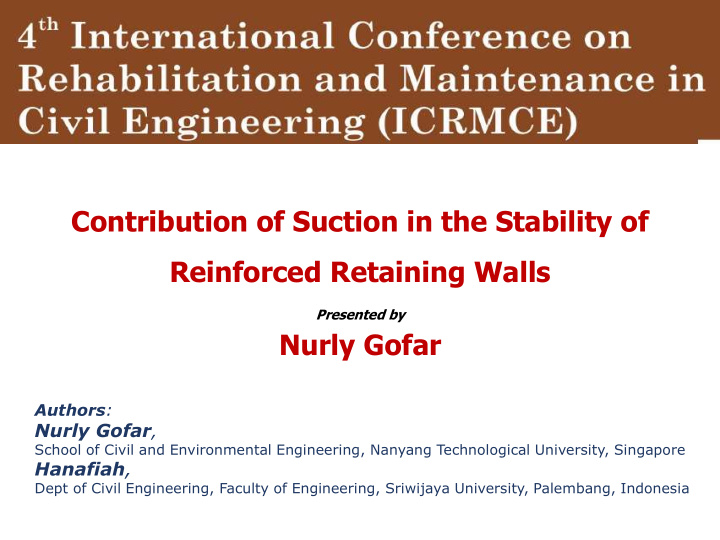



Contribution of Suction in the Stability of Reinforced Retaining Walls Presented by Nurly Gofar Authors : Nurly Gofar , School of Civil and Environmental Engineering, Nanyang Technological University, Singapore Hanafiah , Dept of Civil Engineering, Faculty of Engineering, Sriwijaya University, Palembang, Indonesia
Objectives To evaluate the contribution of cohesion (derived from soil’s mineralogy and suction) on the stress transferred to the reinforcing element using three different methods (A, B and C) . Scope of works Analyses were carried out on a typical reinforced soil retaining wall (3.6 m high, sloping at 70 o to horizontal, and reinforced by six geotextile layers). The reinforced backfill was cohesive soil with total cohesion of 15 kPa. A parametric study was performed for a range of suctions from 10 to 50 kPa with intervals of 10 kPa. 2
Case studied Ref: Gofar, 1994
Components of Reinforced soil wall for case study Components Material Properties c’ = 15 kPa ; f ’ = 30 o ; g = 20.5 kN/m 3 Backfill soil Compacted in-situ soil T u = 20 kN/m; E at e =10% = 118 kN/m; Reinforcement Geotextiles A = 5 × 10 -4 m2 Facing Element Geotextiles Wrap around face c’ = 5 kPa ; f ’ = 28 o ; g = 17.5 kN/m 3 Foundation soil Cohesive
Methods considered in the study Method Reference Methodology A Wright and Duncan (1991) Stability analysis of Reinforced slope Koerner (2005) using SLOPE/W (Geoslope Intl, 2012) B AASHTO (2009), FHWA Consider suction by adopting (2009) Rankine’s/Coulomb’s lateral pressure distribution on retaining walls C Allen & Bathurst (2015) Simplified stiffness method (using Empirical equation for effect of suction) Assumptions involved Direction of Failure plane reinforcement force
Results: Baseline case ; c = 0 External stability FoS sliding = 2.20; FoS overturning = 9.72; FoS bearing capacity = 7.16
Results: Baseline case ; c = 0 Tensile / Pull- force in each reinforcing element calculated using Methods A, B, and C
Suction values Effect of suction and total cohesion Method B 0 - 2 c K a Total cohesion Suctio c = c’ + ψ tan f b (kPa) n ( ψ) kPa s ’ v K a 0 s ’ v K a - 2 c K a 0 0 15 10 18.6 Method C 20 22.3 Φ c = e l c/ g H 30 25.8 where 0 ≥ Φ c ≥ 1 s ’ v K a × c 40 29.6 50 33.2 s ’ v K a
Effect of suction on the Normalized Tensile / Pull- force in each reinforcing element calculated using Methods A, B, and C 9
Effect of suction on the internal stability of reinforced soil retaining wall 10
Conclusions 1. The presence of suction decreases the maximum force resisted by the reinforcing element. However, methods A, B, and C showed different degrees of influence of suction on the stress transferred to the reinforcing element . 2. The contribution of cohesion on the current design guidelines by adopting Rankine’s horizontal pressure distribution in the retaining wall for active condition provides a more reasonable effect as compared to the simplified stiffness method. Therefore, the contribution of suction as part of cohesion existing in the cohesive backfill could be considered for the stability analysis of reinforced soil retaining walls using the available design guidelines. 3. There is an increase in the local stability of the reinforced soil retaining wall due to suction. However, in order to preserve the contribution of the suction in the stability of the wall, the compacted backfill soil should be maintained by protecting the wall from rainfall infiltration, rise of the ground water table and seepage from the back of the reinforced zone. 11
12
Recommend
More recommend